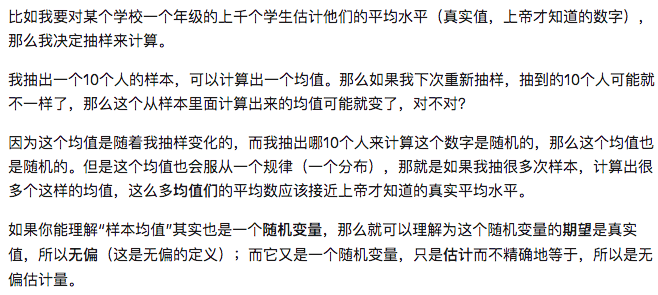This post is about my learning process of probability and statistics.
Probabilistic Systems Analysis and Applied Probability
[Discrete Stochastic Processes]
Mathematics for Computer Science
Probability
This chapter is based on the book “Mathematics for Computer Science”.
Event and Probability
Definition
A countable sample space $S$ is a nonempty countable set. An element $w \in S$ is called an outcome. A subset of $S$ is called an event.

The Four Step Method
In order to understand what event and probability are, we are going to introduce a problem and solve with a four-step method.
Suppose you’re on a game show, and you’re given the choice of three doors. Behind one door is a car, behind the others, goats. You pick a door, say number 1, and the host, who knows what’s behind the doors, opens another door, say number 3, which has a goat. He says to you, “Do you want to pick door number 2?” Is it to your advantage to switch your choice of doors?
In order to answer this question, we want to know whether we can increase the possibility of winning by switching the door. Therefore, our goal becomes probability computation and The-Four-Step-Method is commonly used to perform this task.
Step 1: Find the Sample Space
In this step, our goal is to determine the all the possible outcomes of the experiments. A typical experiment usually involves several steps. For example, in our problem setting, our experiment has the following steps:
- Put a car in a random door.
- Pick a door.
- Open another door with a goat behind it.
Every possible combination of these randomly-determined quantities is called an
outcome. The set of all possible outcomes is called the sample space for the experiment.
Considering the small sample space in this experiment, we are going to use a tree structure to represent the whole space.
Specifically, for the first step: put a car in a random door. Since there are three available door, so we have three possibilities:
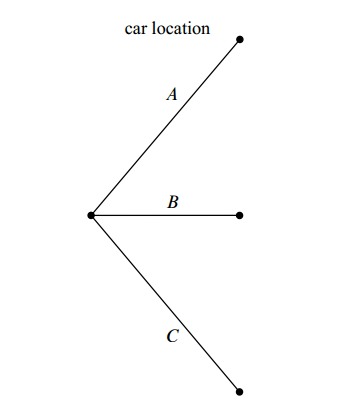
Here, A, B and C are door names.
In the second step, for each car possible location, a user have three possible way to choose a door which he thinks the car is behind:
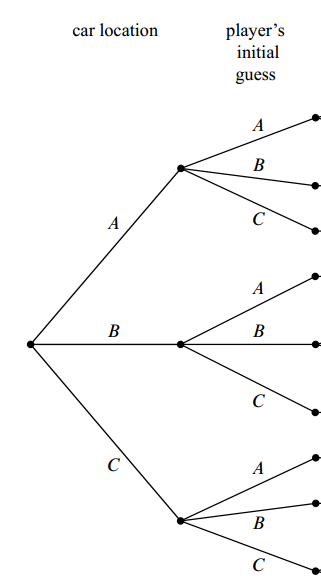
In the final step, we try to reveal a door with a goat behind it. For example, say the car is behind door A and the user choose the door A, then we can reveal either of the doors, i.e., B or C, since goats are both behind these two doors. But if the car is in location A and the user choose the door B, then we can only reveal the door C. The full tree structure is as following:
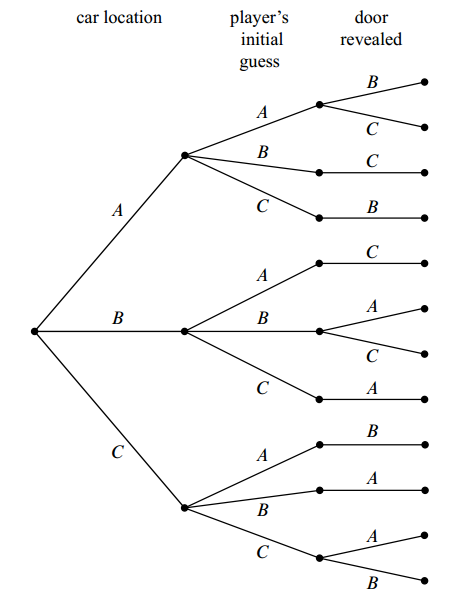
Now let’s relate this picture to the terms we introduced earlier: the leaves of the
tree represent outcomes of the experiment, and the set of all leaves represents the
sample space.
Thus in this experiment, there are 12 outcomes. If we represent each outcome in the format: (door with car, door chosen, door opened with a goat behind), we have the sample space :

Step 3: Define Events of Interest
A set of outcomes is called an event. Each of the preceding phrases characterizes
an event. For example, the event [prize is behind door C] refers to the set:
and the event [prize is behind the door first picked by the player] is:
Remember our goal is the probability of wining if the user switches the door, so the door with prize is different from the door opened, i.e., the 1st element is different from the 3rd element of an outcome; and since we are going to switch the door, so the door chosen is differnt the door opened, i.e., the three elements of an outcome should be different. Therefore, this event can be represented by:
We can mark the outcomes in the tree diagram:
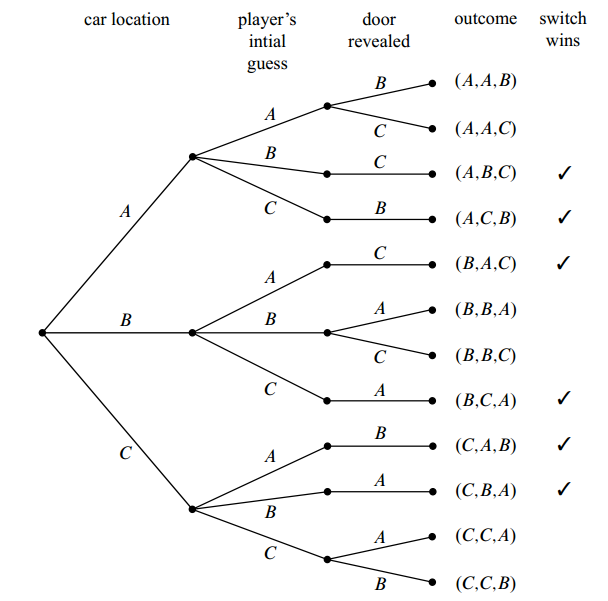
Step 3: Determine Outcome Probabilities
The goal of this step is to assign each outcome a probability, indicating the fraction of the time this outcome is expected to occur. And the sum of all the outcome probabilities must equal one, reflecting the fact that there must be an outcome. We are going to break the task of determining outcome probabilities into two stages.
Assign Edge Probabilities
For example, for the car location field, probability of car behind door A is $\frac{1}{3}$, so we assign $\frac{1}{3}$ to that edge. Then for the player’s initial guess, the probability of each choice is also $\frac{1}{3}$. Say the player choose door A, then for door revealed filed, each possibility is $\frac{1}{2}$. But if the player choose the door B, then we can only reveal door C, so the probability is 1.
Compute Outcome Probabilities
For each outcome, we multiply the edge probability and get the probability of this outcome.
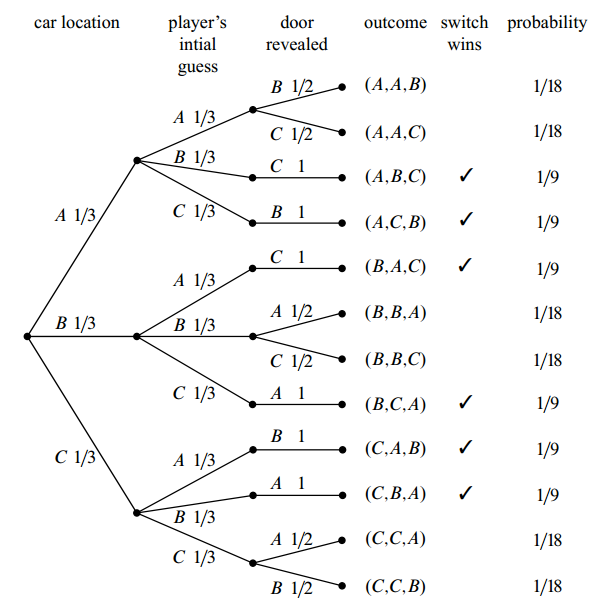
Step 4: Compute Event Probabilities
Now we have the probability of each outcome, so we can compute an event probability by adding all the outcome probability of that event.
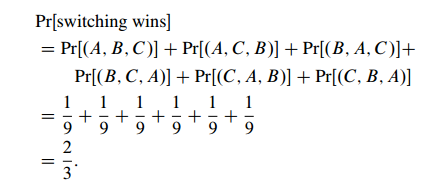
It means that we have the $\frac{2}{3}$ probability to win if we switch the doors.
Independence



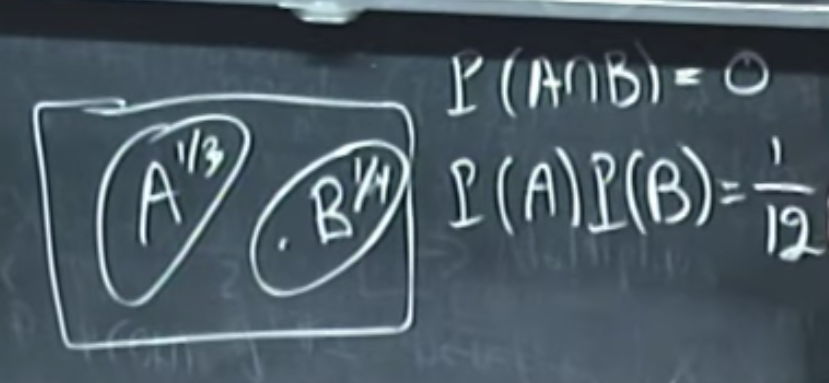
Based on the pic, $P(AB)\ne P(A)P(B)$, so event A and event B are not independent event.

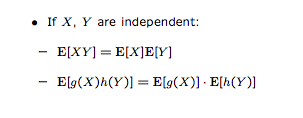

Random Variables
Definition A random variable $R$ is a function, mapping the sample space to a number.
Example
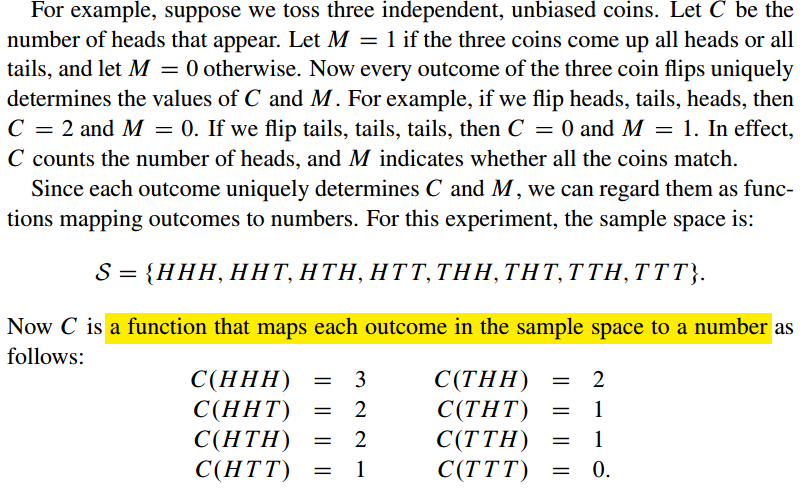
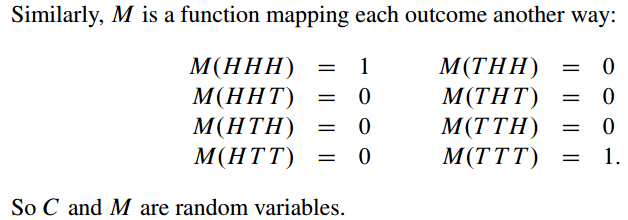
Indicator Random Variables
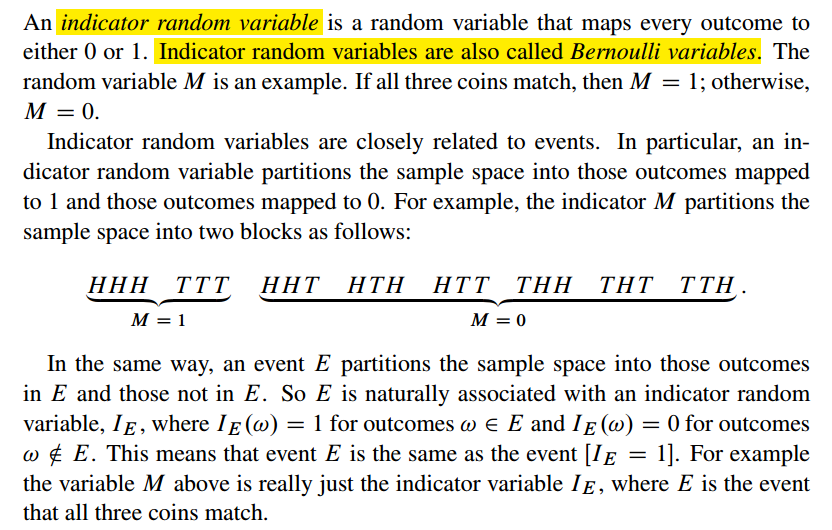
Distribution Functions
Bernoulli Distributions

Uniform Distributions


Binomial Distributions
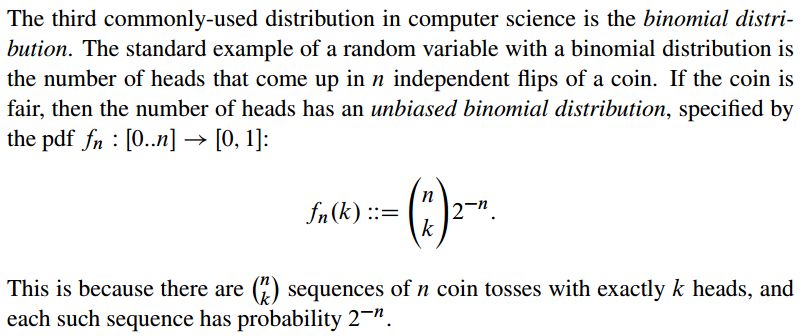

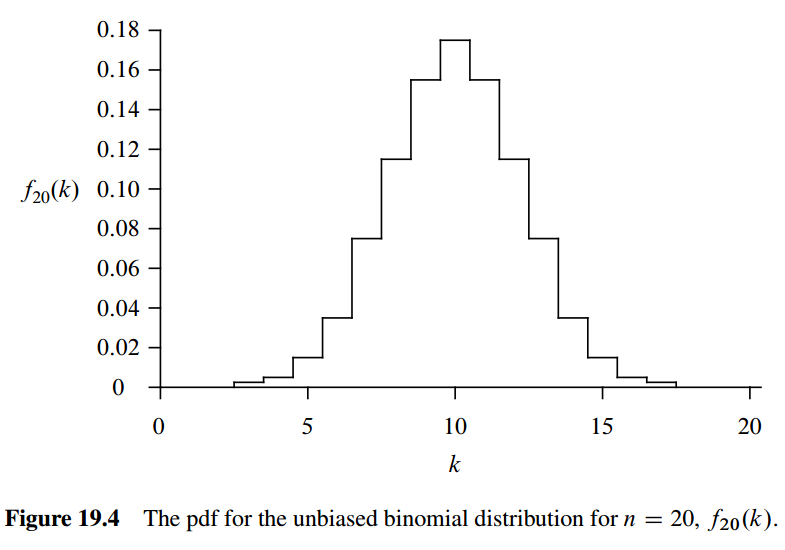
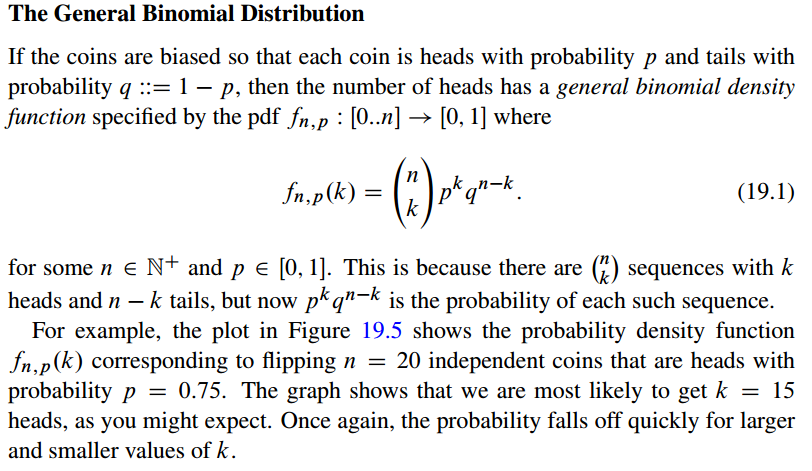

Expectations

The Expected Value of a Uniform Random Variable

The Expected Value of a Reciprocal Random Variable
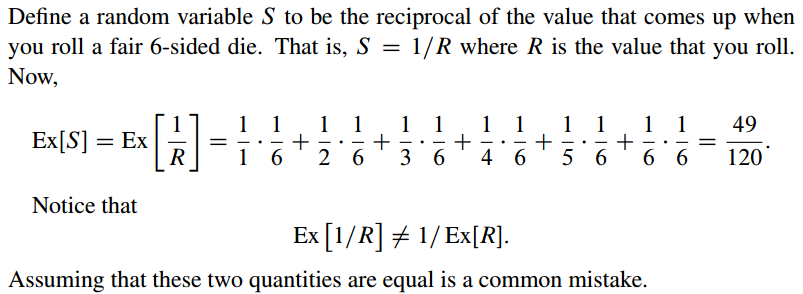
The Expected Value of an Indicator Random Variable

Discrete Random Variables
Probability mass function (PMF)
it is the probability of a discrete random variable; while in continus setting, the probability of a random variable is called PDF.
Expectation
- Average in large number of repetitions the experiment
Properties of expectations

- Once x is determined, then y is determined; so the probability of y is the probability of x;
If $\alpha , \beta$ are constants, then:
But if A and B are two independent variables, then
Variance
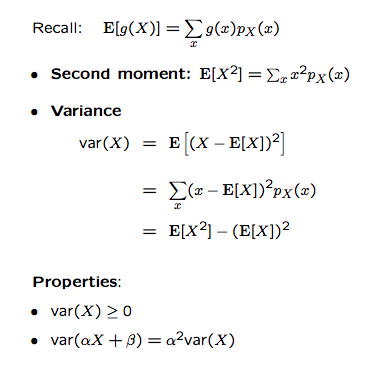
- since $X$ is random while $E(X)$ is a number, so $X-E(X)$ is a random variable.
- variance measures the average square distance from the mean.
- a big variance means the variable are far away from the center while a small one means the variables are tightly concentrated around the mean value.
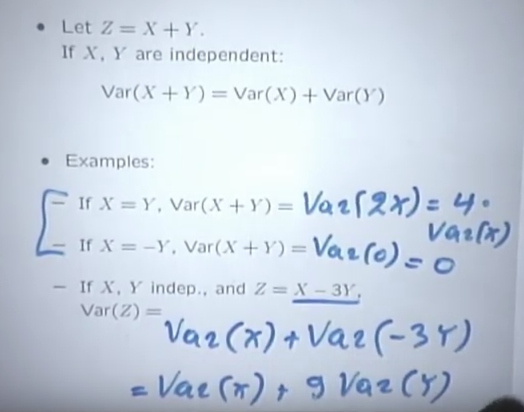
In the example, since $X=Y$, then $X$ and $Y$ are not independent, so ..
Standard deviation
Covariance
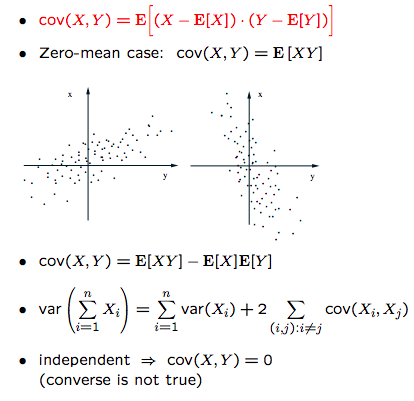
Correlation coefficient
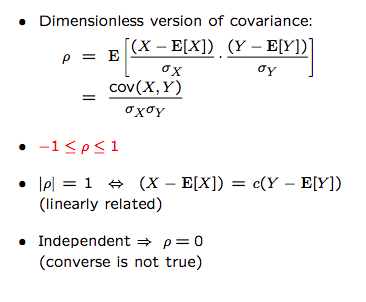
Binomial Random Variable
Definition


Binomial mean and variance
$X= # $ of successes in $n$ independent trials
$X_i=\left\{\begin{align} 1& & \text{if success in trial i}\\0&&\text{otherwise}\end{align}\right.$
$E(X_i)=p$
$E(X_i)=p1+(1-p)0$
$E(X)=np$
$E(X)=E(x_1,x_2,…,x_n)=E(x_1)+E(x_2)+…+E(x_n)=np$
$Var(X_i)=p-p^2$
$Var(X_i)=E(X_i^2)-E(X_i)^2$
$X_i^2=\left\{\begin{align} 1& & \text{if success in trial i}\\0&&\text{otherwise}\end{align}\right.$
So $E(X_i^2)=1p+0(1-p)=p$
$Var(X_i)=E(X_i^2)-E(X_i)^2=p-p^2$
$Var(X)=n(p-p^2)$
$Var(X)=Var(X_i,X_2,…,X_n)$
because $X_i$ is independent to each other, so
$Var(X)=Var(X_i,X_2,…,X_n)=Var(X_1)+Var(X_2)+…+Var(X_n)=nVar(X_i)$
Example-Hat Problem
$n$ people throw their hats in a box and then pick one at random.
Let $X$ be the number of people who get their own hat. We want to find out $E(X)$. This is Binomial distribution:
$X_i=\left\{\begin{align} 1& & \text{if i selects his hat}\\0&&\text{otherwise}\end{align}\right.$
$P(X_i)=\frac{1}{n}$
$E(X_i)=1\frac{1}{n}+0(1-\frac{1}{n})=\frac{1}{n}$
the $X_i$ are not independent
$E(X)=E(X_1)+E(X_2)+…+E(X_n)$ is always true no matter whether $X_i$ are independent or not.
$E(X)=E(X_1)+E(X_2)+…+E(X_n)=n*\frac{1}{n}=1$
$Var(X)=E(X^2)-E(X)^2=E(X^2)-1$
because $X$ is the number of people who has his hat, so $X=X_1+X_2+…+X_n$, then $X^2=\sum_i X_i^2+\sum_{i,j}X_iX_j$
$Var(X)=E(X^2)-1=nE(X_i^2)+n(n-1)E(X_iX_j)-1$
$E(X_i^2)=E(X_i)=\frac{1}{n}$
$P(X_iX_j=1)=P(X_i=1)P(X_J=1|X_i=1)=\frac{1}{n}\frac{1}{n-1}=E(X_iX_j)$
$Var(X)=E(X^2)-1=nE(X_i^2)+n(n-1)E(X_iX_j)-1=n\frac{1}{n}+n(n-1)\frac{1}{n}\frac{1}{n-1}-1=1$
Continuous Random Variable
PDF (Probability Density Function) :
$X$ has PDF $f(x)$ if $P(a\le{X}\le{b})=\int_{a}^{b}f(x)$
According to this definition, the probability of one point is 0: $P(a\le{X}\le{a})=\int_{a}^{a}f(x)=0$

so pdf describes the the probability of intervals.
n
Means and Variances
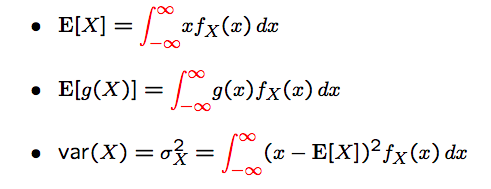
continuous uniform r.v.

- $f(x)=\frac{1}{b-a},a\le x \le b$
- $E(X)=\int_{a}^{b}x\frac{x}{b-a}=\frac{a+b}{2}$

Cumulative distribution function(CDF)
if $X$ has PDF $f$, then the CDF is $F(X)=P(X\le{x})=\int_{-\infty}^{x}f(t)dt$
Gaussian (normal) PDF
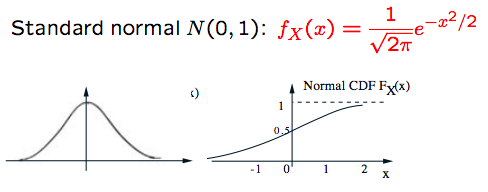
The factor $\frac{1}{\sqrt{2\pi}}$ is to make the calculus equal 1.
$E(X)=1, Var(X)=1$

Let $Y=aX+b$, then
$E(Y)=a\mu +b$, $Var(Y)=a^2 \sigma^2$
Fact: $Y\sim N(a\mu+b,a^2\sigma^2)$, which means linear functions of normal random variabls are themselevs normal.
If $X\sim N(\mu,\sigma^2)$, then $\frac{X-\mu}{\sigma}\sim N(0,1)$
so based on this transform, we can simplify our cdf calculation:

Multiple Continuous Random Variables
Joint PDF
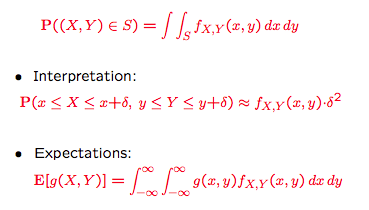
From the joint to the marginal:
$f_X(x)=\int_{-\infin}^{\infin}f_{X,Y}(x,y)dy$
$X$ and $Y$ are called independent if:
$f_{X,Y}(x,y)=f_{X}(x)f_{Y}(y)$
Buffon’s needle
problem setting
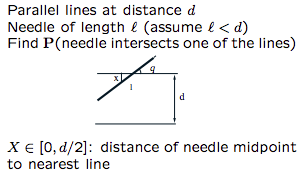
analysis
$X$, $\Theta$ are uniform and independent to each other
$f_{X,\Theta}(x,\theta)=f_X(x)f_{\Theta}(\theta)=\frac{2}{d}\frac{2}{\pi}$, where $0\le x \le \frac{d}{2}$, $0\le \theta \le\frac{\pi}{2}$
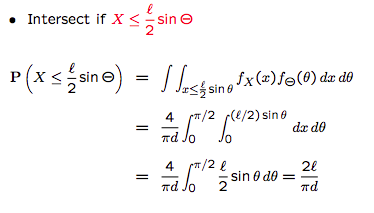
conditioning

Stick-breaking example
problem setting
Break a stick of length $l$ twice: break at $X$ uniformly in $[0,l]$; then break at $Y$ uniformly in $[0,X]$
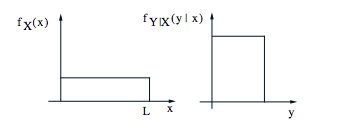
analysis
$f_{X,Y}(x,y)=f_{X}(x)f_{Y|X}(y|x)=\frac{1}{l}\frac{1}{x}$
$E(Y|X=x)=\int yf_{Y|X}(y|X=x)dy=\int_{0}^{x}y\frac{1}{x}dy=\frac{x}{2}$

Derived Distribution
Method
The discrete value bayes

The continuous counterpart

discrete $x$ and continuous $y$

continuous $x$ and discrete $y$

Examples
Example One
Say $X : $ uniform on $[0,2]$. And we want to the PDF of $Y=X^3$.
Firstly, we calculate the PMF of $Y$, $F_Y(y)$, where $y\in[0,8]$. According to the definition of PMF,
And $Y=X^3$, so we have:
Now we want to calculate the mass probability of $X\le y^{\frac{1}{3}}$. We know that $X$ is uniform, and according to the following pic, $P(X\le y^{\frac{1}{3}})$ is the area of length=$ y^{\frac{1}{3}}$ and height=$\frac{1}{2}$
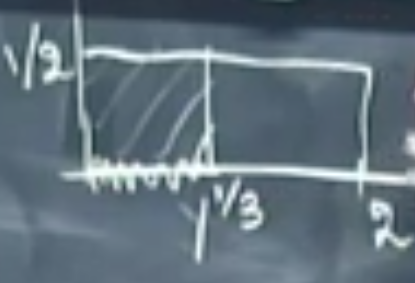
so we have
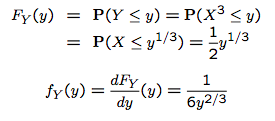
Example Two
Calculate the PDF of $Y=aX+b$.
Then the PDF is:
Because the $P(X\le x)=F_X(x)$,
Then the PDF is
So overall,
Bernoulli process

Definition
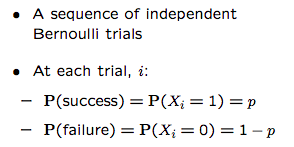
Properties
There is a random process and the sequence of random variables is $X_1, X_2,…$
And for the infinite sequence and no matter what the variable value is, the probability of infinite sequence is :
Number of success $S$ in $n$ time slots
Let $T_1$ be the number of trials until first success:
Memoryless peoperty: what happens in the past has no effect on the future random provess
Log
乘除 —> 加减
- $log_a(MN)=log_a{M}+log_a{N}$
- $log_a{\frac{M}{N}}=log_a{M}-log_a{N}$
Unbiased estimator
Additive Chernoff Bound

上式即
Lemma说明我们用随机变量的均值$\hat{\phi}$取估计参数$\phi$, 估计的参数和实际参数的差超过一个特定数值的概率有一确定的上界,并且随着样本量m的增大,$\hat{\phi}$越接近$\phi$.
Johnson-Lindenstrauss Lemma
The lemma states that a small set of points in a high-dimensional space can be embedded into a space of much lower dimension in such a way that distances between the points are nearly preserved.
Remarks:
- the new dimention $n$ is decided by data sample number $m$ and error bound $\epsilon$; less error (small $\epsilon$) and more sample points require more dimensions, meaning the new dimension $n$ should not be too small;
- Johnson–Lindenstrauss 引理表明任何高维数据集均可以被随机投影到一个较低维度的欧氏空间,同时可以控制pairwise距离的失真.
